Understanding Insulin for Diabetic Pets: What Every Pet Owner Should Know
By Julie Callahan Clark, DVM, DACVIM
Managing diabetes in your dog or cat may feel overwhelming at first, but with the right knowledge and routine, you can help your friend live a happy and healthy life. One of the most important parts of diabetic care is the proper use and handling of insulin. Whether your veterinarian has prescribed a human insulin like Humulin N or Lantus, or a veterinary insulin like ProZinc or Vetsulin, it’s essential to understand how these medications work, how to administer them safely, and what to watch for.
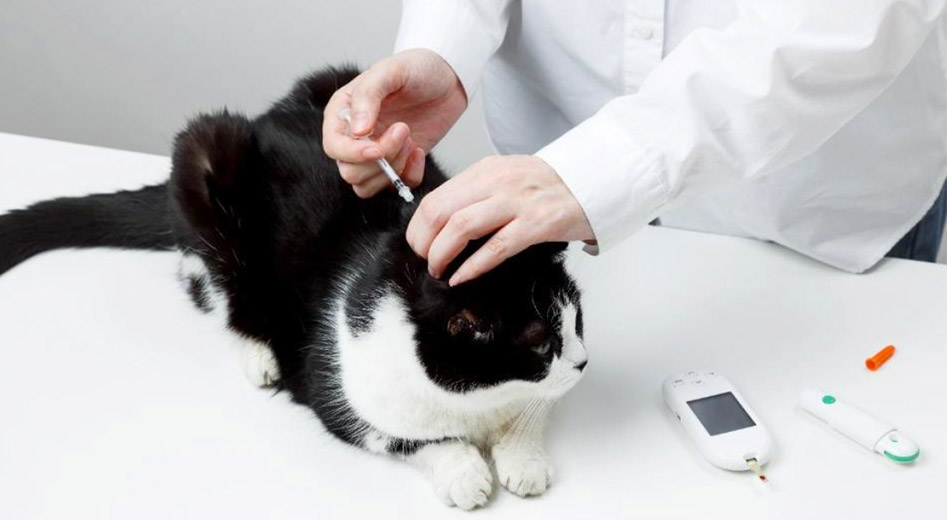
This guide will walk you through the basics of insulin therapy in pets—focusing on types of insulin, handling and storage tips, syringe compatibility, and critical safety precautions.
Types of Insulin Used in Pets
Human Insulin used in Veterinarian Medicine
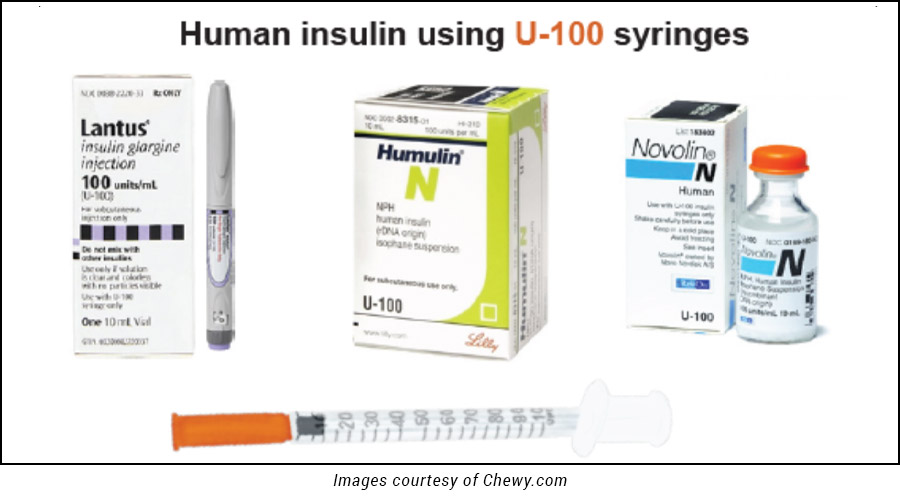
In many cases, veterinarians prescribe human insulin for pets. The two most common types are:
- Humulin N (also known as Novolin N or NPH) – Most commonly used in diabetic dogs, this insulin is intermediate-acting and designed to help regulate blood sugar for 6-10 hours.
- Glargine (Lantus) – A long-acting insulin most commonly prescribed for diabetic cats. It provides a steady release of insulin over 12 to 24 hours, making it a good match for feline metabolism.
These insulins are U-100 insulins, meaning they contain 100 units of insulin per milliliter. When using these products, it is critical to use U-100 insulin syringes to ensure accurate dosing. Using the wrong type of syringe can result in serious underdosing or overdosing.
Glargine comes in two forms: a vial (used with a syringe) and a pen injector. The pen can be convenient for some pet owners, however it’s important to understand proper techniques, especially because precise dosing is crucial. Consult with your veterinarian before attempting to use an insulin pen injector.
Veterinary-Specific Insulin
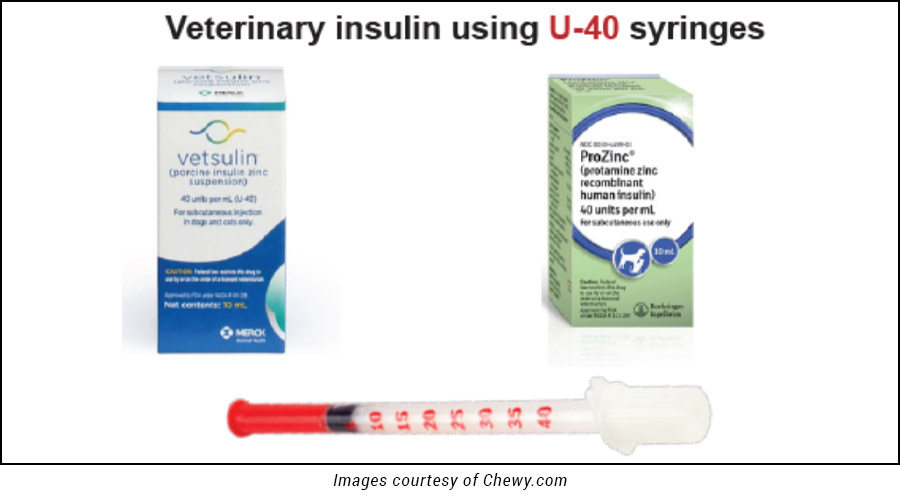
There are also insulins made specifically for animals:
- ProZinc (protamine zinc insulin, a recombinant human product) – A long-acting insulin primarily used in cats (duration of action of 10-14 hours), though sometimes used in dogs.
- Vetsulin (porcine insulin zinc suspension) – A commonly prescribed insulin for dogs and sometimes cats.
These veterinary insulins are U-40 insulins, meaning they contain 40 units of insulin per milliliter. As with U-100 insulins, it's essential to use the matching U-40 insulin syringes.
Why Syringe Matching Matters: A Mathematical Breakdown
The difference between U-100 and U-40 insulin is more than just a label—it directly affects how much insulin is drawn into a syringe.
- A U-100 syringe is calibrated for 100 units per mL. If you accidentally use this syringe with U-40 insulin, you'll underdose your pet—drawing only 40% of the intended amount.
- A U-40 syringe, when used with U-100 insulin, will overdose your pet—delivering 2.5 times the intended dose.
Example:
If your pet is prescribed 5 units of a U-40 insulin, but you accidentally draw it up using a U-100 syringe, you will only give 2 units of insulin—not enough to control blood sugar. If reversed, you could give 12.5 units instead of 5—a potentially life-threatening overdose.
Always double-check the insulin and the syringe concentration. When in doubt, ask your veterinarian or veterinary technician for help.
Choosing the Right Syringe
- When purchasing syringes, make sure the concentration matches the insulin (U-100 for Humulin N, Lantus; U-40 for ProZinc, Vetsulin).
*PRO TIP - U-100 syringes have an orange cap and U-40 syringes have a red cap - Both types of insulin syringes (U-100 and U-40) come in a variety of sizes, depending on how many units your pet needs. Syringes may hold as few as 20 units or as many as 100 units.
- You should never use a non-insulin syringe to administer insulin as you risk inaccurate dosing and may overdose your pet.
- There are syringes with 1/2 unit markings if your pet requires very small or precise doses (common in cats and small dogs). These half-unit markings help improve dosing accuracy and reduce the risk of error.
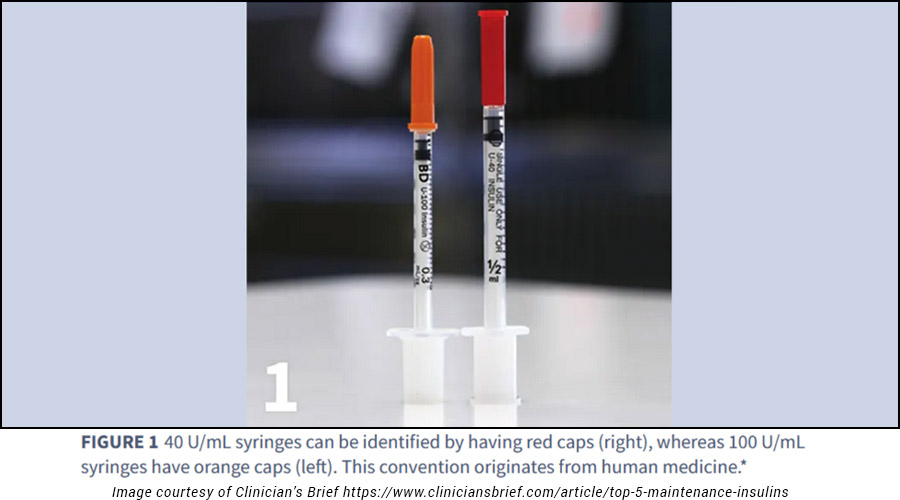
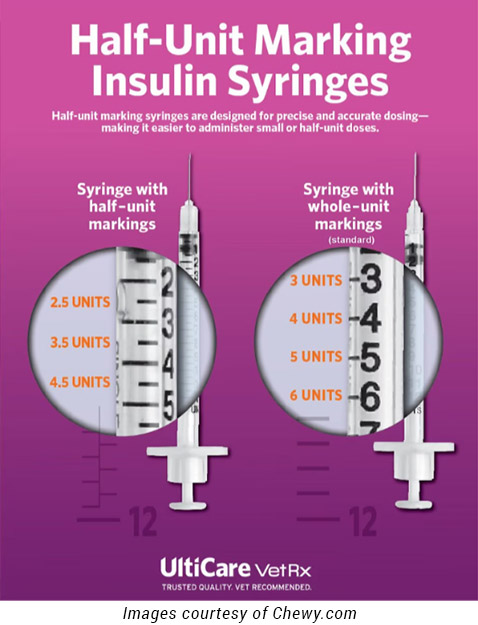
Handling Insulin Properly
Insulin is a sensitive medication. It must be handled and stored correctly to remain effective:
- Storage: Most insulin products should be kept in the refrigerator, ideally between 36°F and 46°F (2°C and 8°C). Avoid freezing.
- Rolling or Shaking:
- Humulin N, Lantus, and ProZinc should be gently rolled between your hands before use to mix the insulin without damaging it.
- Vetsulin, on the other hand, is a suspension and must be gently shaken to evenly distribute the insulin. If not mixed properly, the dosage may be inaccurate.
How Long Does It Last?
While some insulin vials can remain effective for up to 2–3 months, the general veterinary recommendation is to replace the vial every 28–30 days to ensure optimal potency and safety.
Consistency Is Key
For pets with diabetes, maintaining a consistent routine is crucial.
- Timing: Insulin should be given at the same time each day—usually every 12 hours.
- Feeding: Always feed your pet before giving insulin to ensure there is food in their system. Giving insulin on an empty stomach increases the risk of low blood sugar (hypoglycemia).
Skipping meals? Call your veterinarian before giving insulin.
Avoiding Dangerous Mistakes
Don’t Double Dose
If you're not sure whether the insulin injection went in—don’t give another dose. It’s better to potentially miss one dose than to risk giving too much, which can lead to a life-threatening drop in blood sugar.
Communicate with Family Members
Make sure everyone in the household knows who is responsible for giving insulin. Double-dosing can easily happen in busy households if family members don’t communicate.
Low Blood Sugar (Hypoglycemia)
Hypoglycemia is a medical emergency and can occur if:
- Too much insulin is given
- Your pet skips a meal or vomits
- There's a delay in mealtime or excess exercise
Watch for These Signs:
- Weakness or lethargy
- Confusion or disorientation
- Wobbliness or incoordination
- Seizures
- Collapse
What to Do:
- Apply Karo syrup or honey to your pet’s gums (be careful not to get bitten).
- Feed your pet immediately if they are alert enough to eat.
- Seek emergency veterinary care immediately—hypoglycemia can be fatal if not treated promptly.
Final Thoughts: You’ve Got This!
Caring for a diabetic pet takes patience and practice, but with a proper routine, the right tools, and support from your veterinary team, it becomes a manageable part of your daily life. Always follow your veterinarian's instructions, and don’t hesitate to ask questions.
Keep insulin handling and dosing safety top of mind:
- Match the right syringe with the right insulin.
- Stick to a consistent schedule.
- Watch for signs of low blood sugar.
- When in doubt—call your vet.
Your diligence can make all the difference in your pet’s quality of life. With love, attention, and the right care, diabetic pets can thrive for many years to come.

